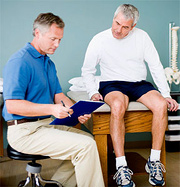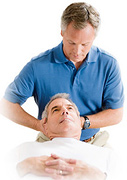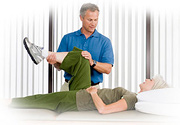Patients often walk into my office for the first time and complain about their severe back pain with comments like, “Even moving my eyes hurts!” At this stage, most first-time back pain sufferers are willing to do almost anything to relieve their pain. Those few fortunate individuals who don’t suffer from back pain can’t fully appreciate the kind of personal anguish, suffering and debilitation this universal problem can cause. It can incapacitate an individual, relegating them to the status of an invalid.
I hear essentially the same questions, regardless of the patient: How can the vertebrae cause so much pain? What can I do immediately to get rid of the pain and discomfort? Do medications work and are they harmful? Will therapy or chiropractic help me? Is surgery the only option? How can I know what I should try?
The thought of surgery is frightening to most people, and for good reason. Surgical procedures, particularly back/spine surgeries, carry with them the possibility of permanent disability or life in pain. More and more people faced with the option of surgery are discovering that consulting a doctor of chiropractic is their best bet because chiropractors study the spine, treat conservatively and refer to other specialists if needed.
What Causes Back Pain?
 Pain often is the result of inflammation caused by strain, sprain or some other structural imbalance to the spine. Injury to the disc (that jelly-like cushion between the vertebrae) also can cause discomfort. Weak muscles, poor posture, excessive strain, and wear-and-tear generally associated with aging all can play a roll in causing back pain.
Pain often is the result of inflammation caused by strain, sprain or some other structural imbalance to the spine. Injury to the disc (that jelly-like cushion between the vertebrae) also can cause discomfort. Weak muscles, poor posture, excessive strain, and wear-and-tear generally associated with aging all can play a roll in causing back pain.
It’s the “quality of life” issues that really make back pain so personally challenging for millions of individuals afflicted every day. Simple movements – such as brushing your teeth, bending over, sitting in a chair or even going to the bathroom – make back pain a problem that must be dealt with. Otherwise, even the simplest of activities can be agonizingly difficult. There is no broken bone, no cut, no bandage, no outward visible signs others can see, which makes it hard for those afflicted with severe back pain to convince others the problem is real. This often leads to psychological distress and even depression.
What Are Your Options?
Here’s what not to do if you’re suffering from back pain:
Do nothing. Many people have a fear of the pain or a fear of what they might have to endure to get rid of the pain and so they do nothing. That is not an option simply because no one can live with an inability to perform even limited activities of daily living.
Take medication. Others might seek to mask the pain with over-the-counter medication such as aspirin, naproxen or ibuprofen. Even these easy-to-obtain medications carry with them potential complications such as gastrointestinal bleeding, abnormal kidney function and many other possible side effects. If aspirin, the most common and widely used drug, can cause reactions, it’s not surprising that other painkillers such as codeine, oxycodone or morphine can cause even more complications.
One thing often overlooked is the fact that there are no “safe” medications. Each and every one carries with it a list of side effects, symptoms and potential problems, and when taken in combination, it’s an almost impossible task to predict how each individual will react or respond.
There isn’t a strong enough case for judicious use of pain medications, whether prescribed or purchased over the counter. Recent news reports tell us our drinking water is filled with trace amounts of approximately 60 to 80 different medications. There is simply no way to tell how these will react within the body over time. There may be a special time and place for drugs, but they should be reserved for the gravest of circumstances and each medication taken with great care.
Here Are Some Better Options to Try:
 Visit a chiropractor. Your doctor of chiropractic will examine you to determine the underlying cause of your pain. Is it occupational, sports or injury-related; deconditioned and weak muscles and ligaments; spinal dysfunction from poor spinal alignment; disc disease or herniation; spinal malformations from birth; degenerative changes to the spine; or something even more significant such as pain referred from a more life-threatening condition?
Visit a chiropractor. Your doctor of chiropractic will examine you to determine the underlying cause of your pain. Is it occupational, sports or injury-related; deconditioned and weak muscles and ligaments; spinal dysfunction from poor spinal alignment; disc disease or herniation; spinal malformations from birth; degenerative changes to the spine; or something even more significant such as pain referred from a more life-threatening condition?
If clinically warranted, your doctor might consider an X-ray, CT scan or MRI to look at the spine or soft-tissue structures to determine if any of these are causing or contributing to your back pain. Research suggests even smoking contributes to back pain, so your chiropractor might suggest you refrain from smoking. They also might suggest embarking on a weight-reduction program if you are overweight, and may outline a program of easy-to-do home conditioning exercises. Finally, a series of spinal manipulations (adjustments) may be recommended to help realign dysfunctional spinal vertebrae that often cause nerve irritation, muscle imbalance and inflammation around the weak areas of your spine.
Start an exercise program. This can help condition and strengthen muscles that might be weak and causing pain. All exercises should be done under the guidance and supervision of a trained professional and are not recommended during the initial or acute phase of back pain.
Have the right attitude. Many individuals develop an “invalid” attitude and become virtually incapacitated due to mental fear and an inability to cope with the pain. It’s as important to have counseling in pain management attitudes as it is to remove the pain. Pain often is one of the body’s best indicators. The body uses pain as a protective mechanism to prevent the individual from harming themselves or placing their body in a position which may cause more harm. The body does know best and paying more attention to the body is very important in recovery.
Your Best Choice
Your doctor of chiropractic, by education and training, will be able to differentiate the signs and symptoms of disc disease, disc herniations, osteoarthritic-type symptoms or referred pain from underlying serious organ disease. You should tell your doctor if you are having difficulty sleeping due to night sweats, pain, any changes in bowel or bladder control or function, or other changes affecting your normal daily patterns.
Following an initial examination and conservative approach involving many of these suggestions, you should begin to feel some change and relief. On each visit back to the chiropractor, be certain to write down questions you think of between visits. If your doctor of chiropractic does not see some improvement within two to four weeks, they might consider several options for you such as a re-evaluation, advanced diagnostic radiology or consultation with another specialist, such as neurologist, orthopedic doctor, neurosurgeon or physiatrist (pain management specialist). These doctors all work with very different approaches to deal with back pain.
 The good news is that the vast majority of back pain patients can and do obtain relief with chiropractic manipulation and a generally conservative approach to help restore normal function to the spine and improve the conditioning of the entire body.
The good news is that the vast majority of back pain patients can and do obtain relief with chiropractic manipulation and a generally conservative approach to help restore normal function to the spine and improve the conditioning of the entire body.
Under most circumstances, it’s best to avoid self-treatment for too long because even simple bed rest has been proven to be harmful for back pain sufferers. While back pain can be debilitating and painful, extremely confusing and difficult to understand, and prevent even the most simple of life’s daily pleasures, it can be, for the most part, helped with the proper approach and using the most conservative, safe and noninvasive form of care first. The majority of people can benefit quickly, and under the expert guidance of a doctor of chiropractic, return to a healthy, functioning lifestyle again.
By Dr. Louis Sportelli
Louis Sportelli, DC, graduated from Palmer College of Chiropractic in Davenport, Iowa, and maintains a private practice in Palmerton, Pa.